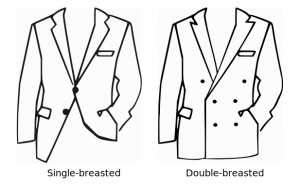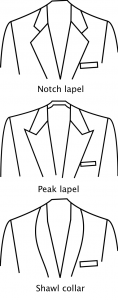For many men, a lack of fashion sense is a point of pride. Relegating clothing decisions to an afterthought is ostensibly equated with a demonstration of manliness. The Modern Urban Gentleman knows better.
The world of fashion is a foreign land to many men. And traveling to an unknown place introduces insecurities. The easiest way to deal with an insecurity is to pretend the underlying subject just doesn’t matter. But fashion does matter. Fashion is confidence, and confidence breeds success.
The Modern Urban Gentleman does not hide from his insecurities, he eliminates them. The gentleman does not ignore his points of weakness, he strengthens them. And the best starting point to strengthen the gentleman’s knowledge of men’s fashion is to discuss the suit.
The story of the suit
The suit is the backbone of the gentleman’s wardrobe. It is such a vital element to the Modern Urban Gentleman that it cannot be sufficiently dealt with in just one column; come back next week for the second installment.
Unfortunately, the wearing of a suit has come to be viewed as a necessity rather than an opportunity. As a result, the suit is treated the same as a t-shirt and jeans: purchased haphazardly and worn without pride. The suit demands the opposite.
The suit is a work of art, coaxed into existence by a craftsman out of hundreds of years of tradition and innovation. The suit is a set of garments cut from a single piece of cloth, most commonly wool. It consists of two pieces, a jacket and pants — or three, by adding a vest, also called a waistcoat. The suit, worn effectively, is complemented by a collection of clothes and accessories to express differing degrees of formality and expressions of style.
The suit has evolved through the centuries from the embroidered and jeweled formalwear of post-Renaissance Europe to the common “lounge” suit of the modern American workplace. As history demonstrates, the suit has been repeatedly redesigned for comfort, making today’s suits a pleasure to wear.
In bygone ages, a man would choose a piece of fabric and his tailor would cut and sew each suit to the customer’s measurements. Today, a suit crafted through that method is called a “bespoke” suit, and the price tag runs in the thousands of dollars. Instead, most men purchase suits “off the rack.”
This development is lamentable, because it creates a disconnect from the craft and the majesty of suit-making. Consequently, the off-the-rack revolution has moved suits from tailor’s shops to department stores, altering the man’s psychological connection to the garment. Now, the suit can be treated as a disposable commodity instead of a revered investment.
But in practical terms, the off-the-rack suit makes dressing well accessible to those who are willing to make an effort to wear it right. By understanding the basics of choosing a style and finding the right fit, the gentleman, with the help of his tailor (a topic for another column), can dress to impress any time he dons the suit.
The elements of the suit
The most common suit style in contemporary America is the single-breasted, as contrasted with the double-breasted that has historically been common in England. This terminology refers to the rows of buttons that fasten the jacket: single-breasted has one row, close to the edges of the jacket; double-breasted has two rows that cause the faces of the jacket to overlap when closed.
Suit jackets also feature a turned-over piece of fabric around the color and along the breast of the jacket, called the lapel. There are three main styles of lapel: the notch, the peak, and the shawl. The notch is the least formal, and the shawl the most, usually only appearing on tuxedo or dinner jackets. Lapel widths have shrunk since the 1970s, and must be matched to the width of the necktie (stay tuned for more on this subject).
Suit pants can be cuffed or uncuffed, a matter of personal taste. The pants also can be pleated or not pleated. I say “can be,” but they never should be pleated; this universally looks bad.
When to wear a suit
The suit has been the standard uniform for men in white-collar careers for decades. Recent years have seen the rise of “business casual,” “blue jeans Fridays,” and even “tech casual.” It is tempting to lament how loosening dress codes are ruining America, but the Modern Urban Gentleman lives in today’s world and understands it is unseemly to be a premature curmudgeon.
Instead, the gentleman applies a simple principle: dress five percent better than those around you. This calls for subtlety — do not wear a three-piece to a Super Bowl party, but do wear a suit to a dinner party, and wear it better than anyone else.
There are other times when the gentleman invariably wears a suit. He does wear a suit (or a tuxedo) to a wedding. He does wear a suit to a cocktail party. If the gentleman goes out for drinks after work, he does not go home and change “into something more comfortable”; the suit will improve his chances at both free drinks and proffered phone numbers. The gentleman absolutely does wear a suit to a funeral — and it is the only time to wear a solid black suit.
Choosing the suit
There are many styles and colors of suits, from the stuffy to the outlandish. Because of the cost associated with a suit, a gentleman’s suit closet must be filled over time. The charcoal suit is the most versatile and is a great first purchase for the new professional.
From there, the gentleman can branch out to the pinstripe and the navy-with-gold-buttons. Several years in, he explores new fabrics to fit the seasons: tweed in fall and winter, khaki in spring and summer. As mentioned above, save the solid black suit for end-of-life memorials.
Once the gentleman has five or six reliable suits in his rotation, he can move to novelty pieces: first, the tuxedo, then seersucker. The Modern Urban Gentleman will give tips on these items in the future.
J.Crew has set the standard for the suit of Modern Urban Gentlemen everywhere. The Ludlow suit is effortlessly stylish, worth purchasing one at the upper end of the Modern Urban Gentleman’s budget at $546 to serve as the go-to showstopper. Banana Republic offers a variably priced line that will turn heads as well.
With suits as low as $399, Suitsupply is changing the online suit-purchasing game. They offer a wide selection, including smart double-breasteds for the well-established gentleman.
If none of these options appeal to the gentleman in you, don’t discount a purchase from the menswear department at the mall. As long as the gentleman understands the principles of cut and fit, to be discussed in this space next week, he can find the diamonds in the rough of any suit rack.
The gentleman who follows these rules immediately sets himself up for success. He will look good. He will feel good. He will project a swagger that attracts the attention of potential romantic partners and impresses potential business assets. He will be well on his way to becoming a Modern Urban Gentleman.


